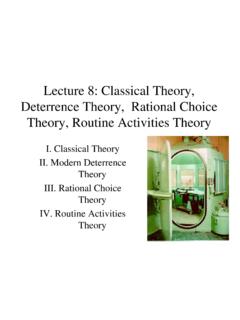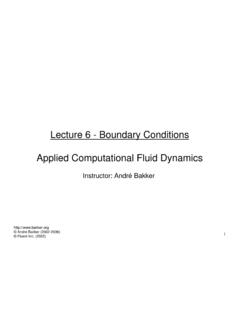Transcription of CHAPTER 8: MATRICES and DETERMINANTS - …
1 (Section : MATRICES and DETERMINANTS ) CHAPTER 8: MATRICES and DETERMINANTS . The material in this CHAPTER will be covered in your Linear Algebra class (Math 254 at Mesa). SECTION : MATRICES and SYSTEMS OF EQUATIONS. PART A: MATRICES . A matrix is basically an organized box (or array ) of numbers (or other expressions). In this CHAPTER , we will typically assume that our MATRICES contain only numbers. Example Here is a matrix of size 2 3 ( 2 by 3 ), because it has 2 rows and 3 columns: 1 0 2 .. 0 1 5 . The matrix consists of 6 entries or elements. In general, an m n matrix has m rows and n columns and has mn entries. Example Here is a matrix of size 2 2 (an order 2 square matrix): 4 1.
2 3 2 . The boldfaced entries lie on the main diagonal of the matrix. (The other diagonal is the skew diagonal.). (Section : MATRICES and DETERMINANTS ) PART B: THE AUGMENTED MATRIX FOR A SYSTEM OF LINEAR EQUATIONS. Example 3x + 2 y + z = 0. Write the augmented matrix for the system: . 2x z = 3. Solution Preliminaries: Make sure that the equations are in (what we refer to now as). standard form, meaning that . All of the variable terms are on the left side (with x, y, and z ordered alphabetically), and There is only one constant term, and it is on the right side. Line up like terms vertically. Here, we will rewrite the system as follows: 3x + 2 y + z = 0.
3 2x z=3. (Optional) Insert 1 s and 0 s to clarify coefficients. 3x + 2 y + 1z = 0.. 2x + 0 y 1z = 3. Warning: Although this step is not necessary, people often mistake the coefficients on the z terms for 0 s. (Section : MATRICES and DETERMINANTS ) Write the augmented matrix: Coefficients of Right x y z sides 3 2 1 0 .. 2 0 1 3 . Coefficient matrix Right-hand side (RHS).. Augmented matrix We may refer to the first three columns as the x-column, the y-column, and the z-column of the coefficient matrix. Warning: If you do not insert 1 s and 0 s, you may want to read the equations and fill out the matrix row by row in order to minimize the chance of errors.
4 Otherwise, it may be faster to fill it out column by column. The augmented matrix is an efficient representation of a system of linear equations, although the names of the variables are hidden. (Section : MATRICES and DETERMINANTS ) PART C: ELEMENTARY ROW OPERATIONS (EROs). Recall from Algebra I that equivalent equations have the same solution set. Example Solve: 2x 1 = 5. 2x 1 = 5. 2x = 6. x = 3 Solution set is 3 .{}. To solve the first equation, we write a sequence of equivalent equations until we arrive at an equation whose solution set is obvious. The steps of adding 1 to both sides of the first equation and of dividing both sides of the second equation by 2 are like legal chess moves that allowed us to maintain equivalence ( , to preserve the solution set).
5 Similarly, equivalent systems have the same solution set. Elementary Row Operations (EROs) represent the legal moves that allow us to write a sequence of row-equivalent MATRICES (corresponding to equivalent systems) until we obtain one whose corresponding solution set is easy to find. There are three types of EROs: (Section : MATRICES and DETERMINANTS ) 1) Row Reordering Example 3x y = 1. Consider the system: . x+ y=4. If we switch ( , interchange) the two equations, then the solution set is not disturbed: x+ y=4.. 3x y = 1. This suggests that, when we solve a system using augmented MATRICES , . We can switch any two rows. Before: R1 3 1 1.
6 R2 1 1 4 . Here, we switch rows R1 and R2 , which we denote by: R1 R2. After: new R1 1 1 4 .. new R2 3 1 1 . In general, we can reorder the rows of an augmented matrix in any order. Warning: Do not reorder columns; in the coefficient matrix, that will change the order of the corresponding variables. (Section : MATRICES and DETERMINANTS ) 2) Row Rescaling Example 1 1. x+ y=3. Consider the system: 2 2. y=4.. If we multiply through both sides of the first equation by 2, then we obtain an equivalent equation and, overall, an equivalent system: x + y = 6.. y=4. This suggests that, when we solve a system using augmented MATRICES .
7 We can multiply (or divide) through a row by any nonzero constant. Before: R1 1 / 2 1 / 2 3 .. R2 0 1 4 . Here, we multiply through R1 by 2, which we ( ) (. denote by: R1 2 R1 , or new R1 2 old R1 ). After: new R1 1 1 6 .. R2 0 1 4 . (Section : MATRICES and DETERMINANTS ) 3) Row Replacement (This is perhaps poorly named, since ERO types 1 and 2 may also be viewed as row replacements in a literal sense.). When we solve a system using augmented MATRICES , . We can add a multiple of one row to another row. Technical Note: This combines ideas from the Row Rescaling ERO. and the Addition Method from CHAPTER 7. Example x + 3y = 3. Consider the system.
8 2x + 5y = 16. Before: R1 1 3 3 .. R2 2 5 16 . Note: We will sometimes boldface items for purposes of clarity. It turns out that we want to add twice the first row to the second row, because we want to replace the 2 with a 0.. We denote this by: ( ) ( ). R2 R2 + 2 R1 , or new R2 old R2 + 2 R1. old R2 2 5 16. + 2 R1 2 6 6. new R2 0 11 22. (Section : MATRICES and DETERMINANTS ) Warning: It is highly advised that you write out the table! People often rush through this step and make mechanical errors. Warning: Although we can also subtract a multiple of one row from another row, we generally prefer to add, instead, even if that means that we multiply through a row by a negative number.
9 Errors are common when people subtract. After: old R1 1 3 3 .. new R2 0 11 22 . Note: In principle, you could replace the old R1 with the rescaled version, but it turns out that we like having that 1 in the upper left hand corner! If matrix B is obtained from matrix A after applying one or more EROs, then we call A and B row-equivalent MATRICES , and we write A B . Example 1 2 3 7 8 9 .. 7 8 9 1 2 3 . Row-equivalent augmented MATRICES correspond to equivalent systems, assuming that the underlying variables (corresponding to the columns of the coefficient matrix) stay the same and are in the same order. (Section : MATRICES and DETERMINANTS ) PART D: GAUSSIAN ELIMINATION (WITH BACK-SUBSTITUTION).
10 This is a method for solving systems of linear equations. Historical Note: This method was popularized by the great mathematician Carl Gauss, but the Chinese were using it as early as 200 BC. Steps Given a square system ( , a system of n linear equations in n unknowns for some n Z+ ; we will consider other cases later) . 1) Write the augmented matrix. 2) Use EROs to write a sequence of row-equivalent MATRICES until you get one in the form: If we begin with a square system, then all of the coefficient MATRICES will be square. We want 1 s along the main diagonal and 0 s all below. The other entries are wild cards that can potentially be any real numbers.





